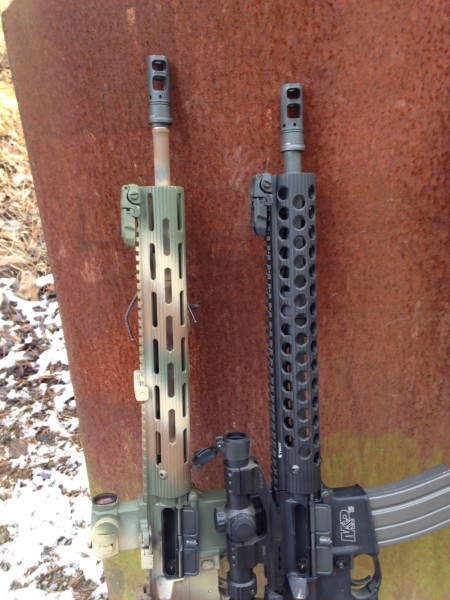You always hear quite a bit about how rifles with mid-length gas systems shoot “softer” than the carbine length brethren. I bought one of my favorite rifles more because of the basic layout, and I like the dude that came up with the concept of the rifle, Kyle Lamb. It is a 16 inch Smith and Wesson VTAC 2. It came factory with a mid-length gas tube. I changed out the brake for a Surefire brake, and then I just added ammo. The rifle has always shot like a dream. Dot travel is minimal. I can hammer quick splits into discreet targets at will.
I got a rare opportunity for a fun test. A good friend of mine had a similar Smith and Wesson rifle. But, for intents and purposes, the only difference between the rifle was the trigger was a SSA-E instead of a Super V, the optic, the barrel was cut to 14.5 inches, and the gas system was carbine length.
I started out with the dot travel test. On a 3×5 card, I fired a 10 shot string at a pace of about one shot ever second. During this phase, I watched the dot on the optic. My rifle has the appearance of very little travel. The dot travels upward toward two o’clock with very little movement. The carbine length gun did about the same on the test. It was a draw on performance.
Next, I moved on to Bill Drills at seven yards. In looking at the times, the mid length gun was a little faster shot to shot. The average times with the mid length hovered around a .16 split, and a .18 for the carbine length. Enough to make a practical difference? I’d say that is too close to call.
I realize the sample size was small. Perhaps there are larger differences between the set up of the gas systems. Another benefit is that there is less wear and tear on the mid-length, and that the mid-length is more reliable. Across a few hundred rounds shooting some standardized drills, I didn’t see a bit of that.
I am a growing believer that the trained can milk performance out of whatever they choose to shoot. It is possible that all the choices we have in gas system lengths, piston versus DI, etc are nothing more than choices.




I’d like to know what buffer weight(s) the two had, if there was any difference in that end?
Thanks!
There’s a problem with your comparison. You compared a 16″ MID to a 14.5″ CAR. Those two gas systems have similar performance. You need to compare a 16″ CAR to a 16″ MID. The difference is that where the gas port is located compared to the muzzle. On a 16″ CAR, it’s obviously further away than either the 14.5 CAR or 16″ MID. You’ll also notice that both the 14.5″ CAR and 16″ MID have similar gas port-to-muzzle distances. Also, you need to consider the SIZE of the gas port too. Many “commercial” grade barrels use oversized gas ports so that junk ammo will cycle reliably but that causes an over-gassed situation when you use NATO spec ammo. I think a fair comparison would be compare two 16’s barrels from the same manuf. that have the same size gas ports.
Before reading the following, note that I’m not an AR expert so if I say something dumb, I won’t be offended if you call me out.
I think the complaint re: carbine length gas isn’t on guns with 14.5″ barrels, but on 16″ barreled guns. The additional barrel length over a M4, without a corresponding change in the gas system, leads to increased dwell time. This of course leads to more gas in the system, leading to an “overgassed” rifle. The gun in your test had carbine-length gas on a 14.5″ barrel, which is as it should be.
My suspicion is that complaints about overgassed rifles are just like complaints about pistols with high bore axes: it’s another excuse scrublords can use for why their splits suck. However, I guarantee you that they will point out the barrel length thing if they’re shown this article.
“I am a growing believer that the trained can milk performance out of whatever they choose to shoot. It is possible that all the choices we have in gas system lengths, piston versus DI, etc are nothing more than choices.”
Concur with the above. Provided the weapon and ammo are reliable, training and mindset matter far more than variations on the weapon design.
DOL-
JMG
While I agree with statement, certain “choices” do have longer learning curves. Why not start with the better tool? When looking to buy a new setup, I see no reason why anyone would go with a carbine gas system (on a 16″ barrel) considering a mid-length doesn’t cost any more.
A good brake in either case nullifies this whole comparison. Were there brakes on either of the rifles you tested?